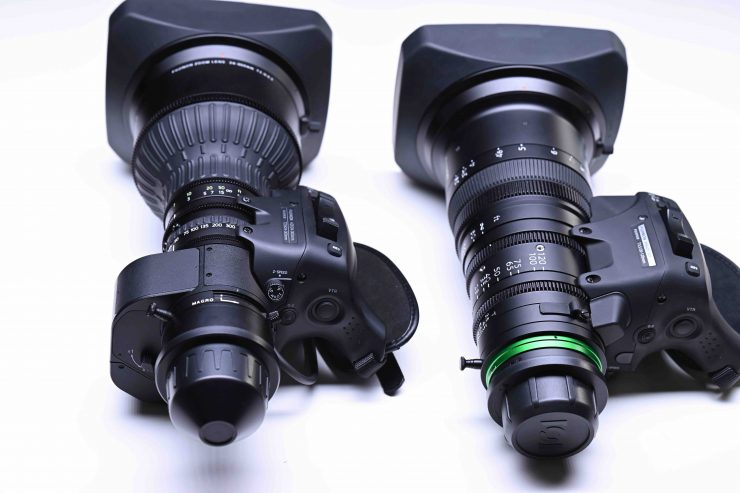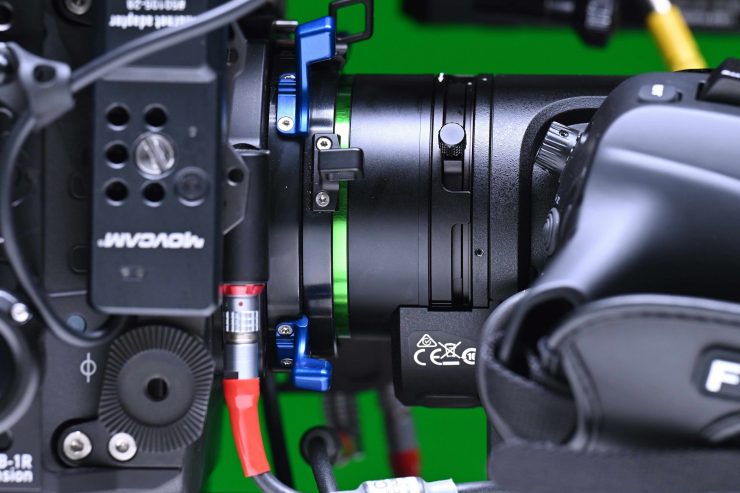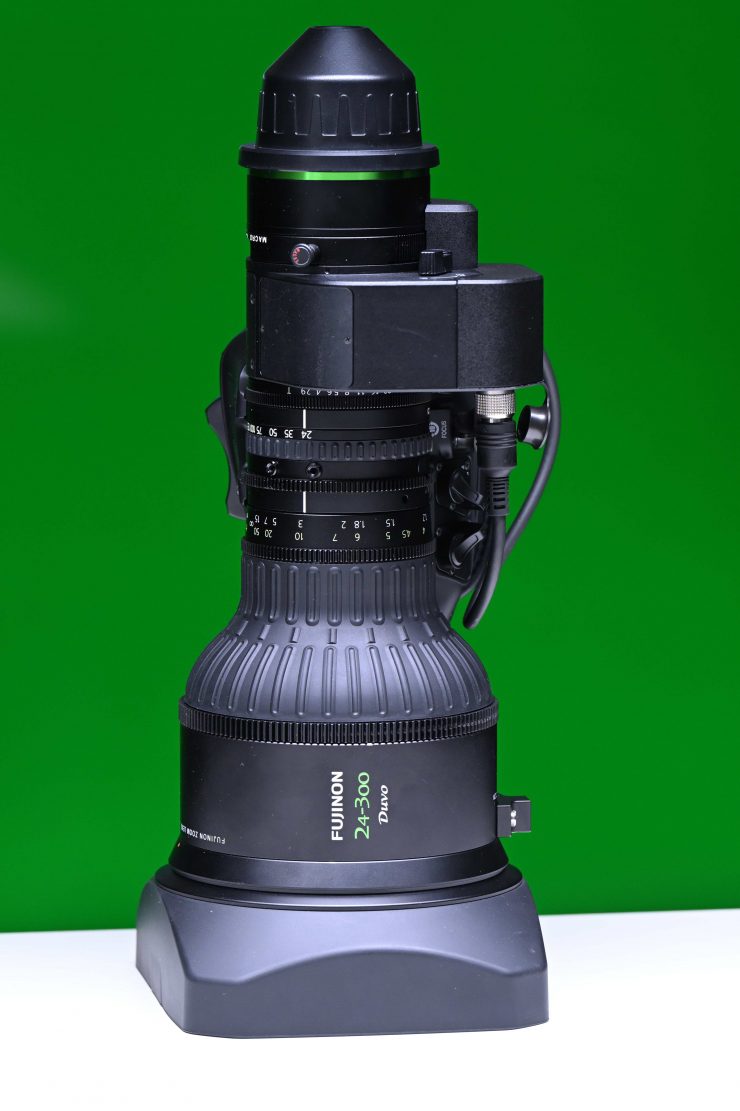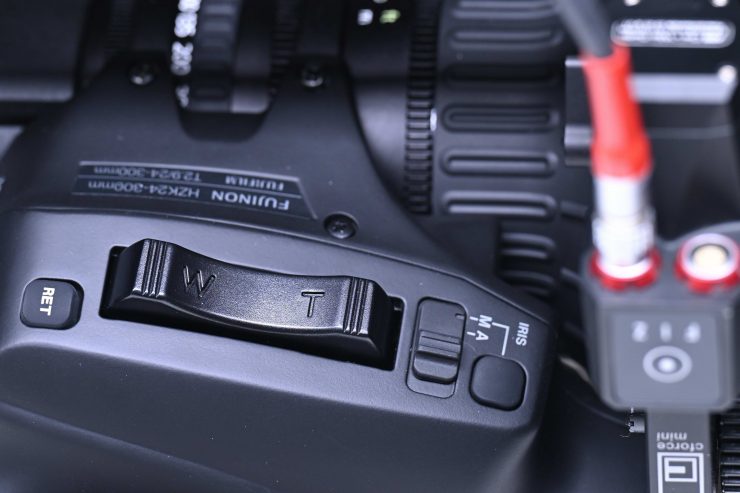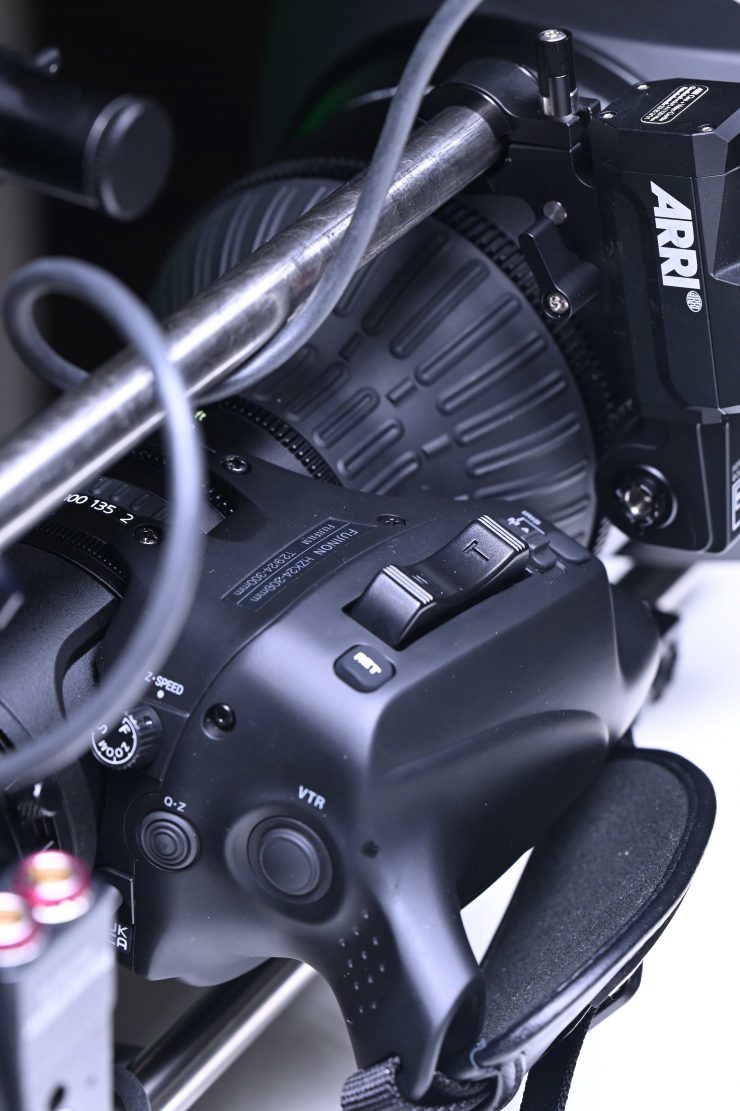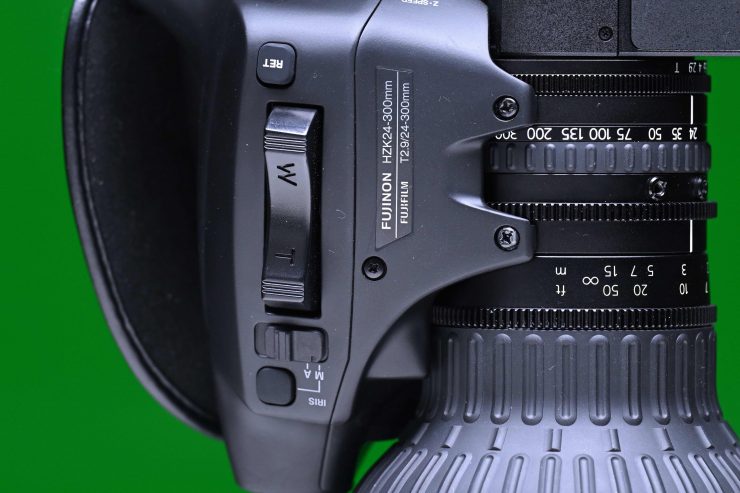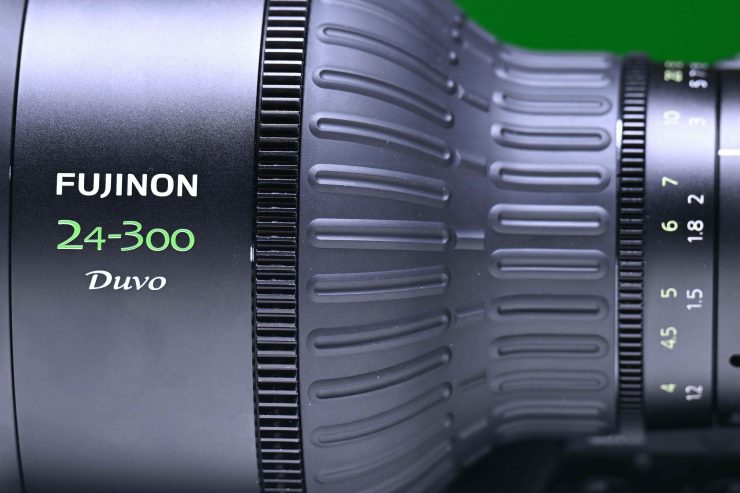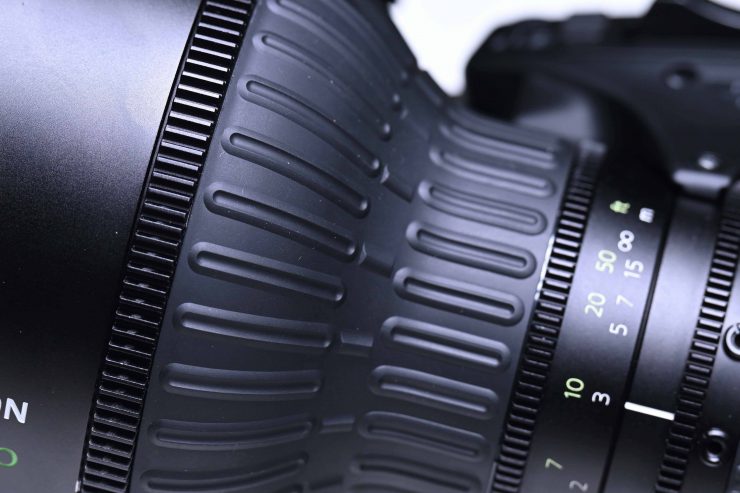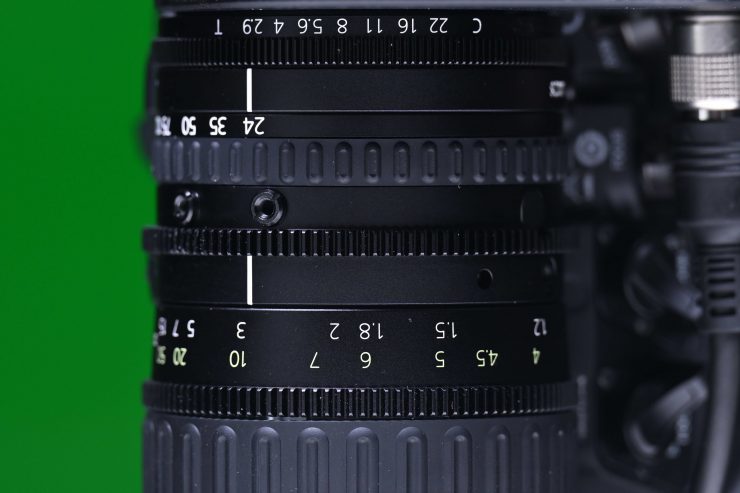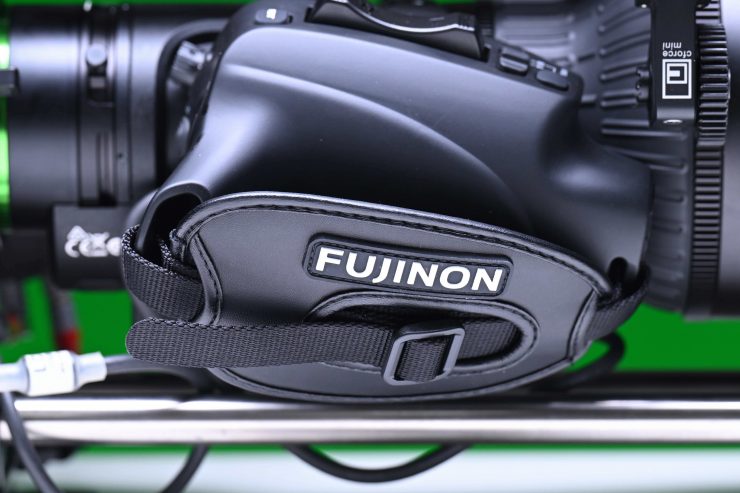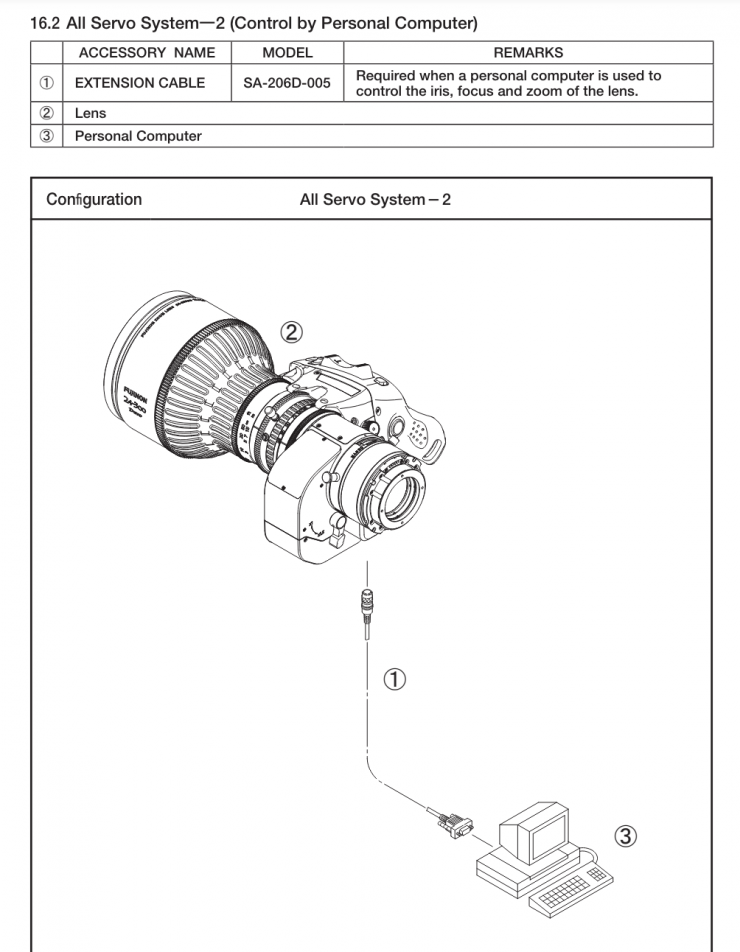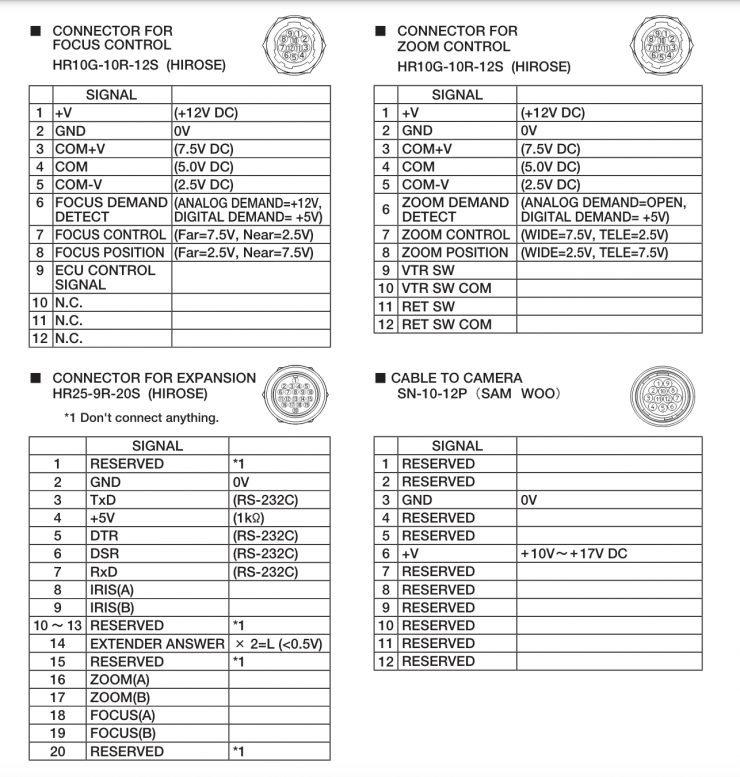
Fujifilm recently announced the price and availability of its FUJINON Duvo HZK24-300mm dual format zoom lens that supports Super 35mm and full-frame sensors (with the 1.5x expander engaged).
The lens was designed to be used with S35 digital cinema cameras that have a PL mount in ENG-type environments for sports, live events, documentaries, etc. I was lucky enough to get hold of the lens and I wanted to put it through its paces.
We first saw the FUJINON Duvo HZK24-300mm at NAB 2023.
Overview
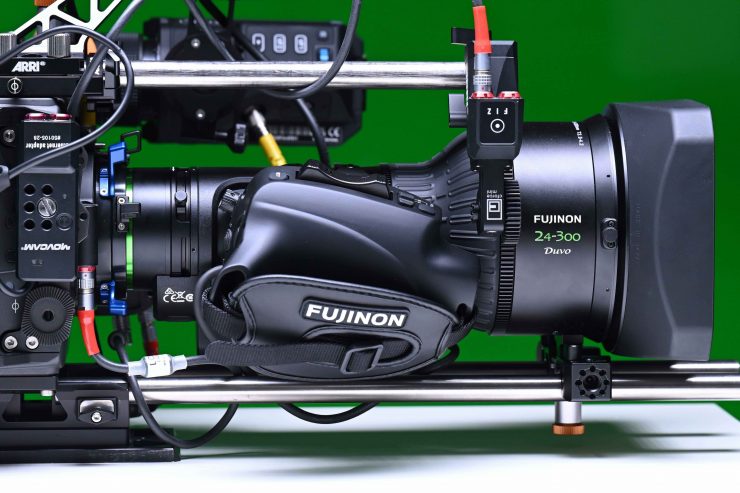
Most cinema lenses have a much smaller zoom magnification ratio than that of broadcast lenses and they weigh a lot more. They also often require a focus puller, which is uncommon in the broadcast industry. Fujifilm set out to change this by creating a compact, lightweight, portable lens that they could add to the Duvo Series lens lineup for coverage of live sporting events, music concerts, documentaries, and wildlife cinematography.
It is best to think of the Duvo HZK24-300mm as the S35 equivalent of a 2/3 ENG lens. Essentially, that is exactly what it was designed for.
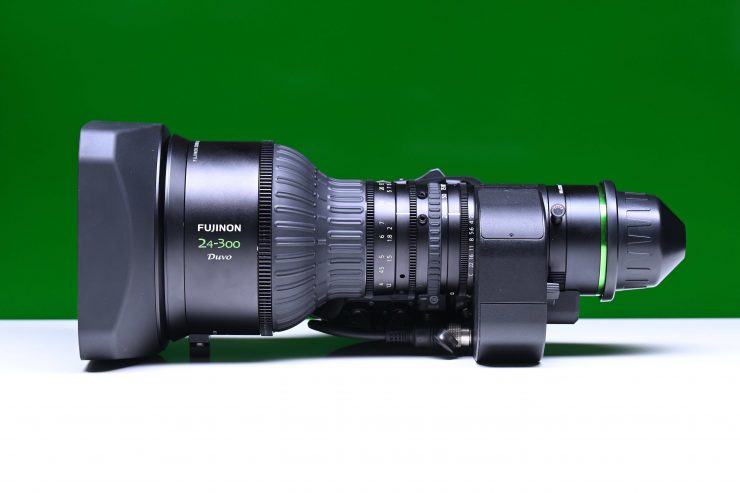
KEY FEATURES
- The 28.5mm diameter image circle covers up to Super35 sensors.
- ENG-style, digital drive unit with zoom rocker switch.
- Pitch gears for focus, zoom, and iris control.
- Power and data/control connections to the camera via the rear PL mount “hot shoe.”
- The 16-bit encoding supports sharing LDS and /i Technology lens data with the camera.
- The barrel markings in metric or imperial measurements are switchable in the field.
- Glow-in-the-dark barrel markings make it easier to read measurements.
- A 280° focus barrel rotation for more precise focus adjustments.
- The 120° zoom rotation
- No shims are required to adjust the flange focal distance.
- Macro focus function available.
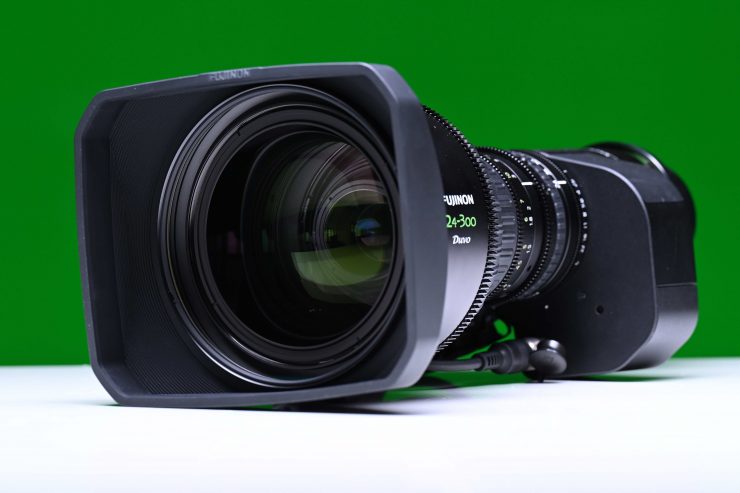
The Duvo 24-300mm delivers a 12.5x zoom, covering the frequently used 24-300mm focal range. By using the built-in 1.5x extender, you can turn the lens into a 36-450mm with the caveat of losing about 1.5 stops of light. The expander need to be engaged if you want it to cover full-frame camera sensors.
The lens has a maximum aperture of T2.9 from the wide-angle end of 24mm to 207mm. Over 207mm it does start ramping up to T4.2.
At 24mm, the lens can focus at a distance of just 10.65″ / 27.05cm. It also features a built-in macro adjustment like you find on a lot of ENG 2/3″ lenses.
This isn’t their first rodeo
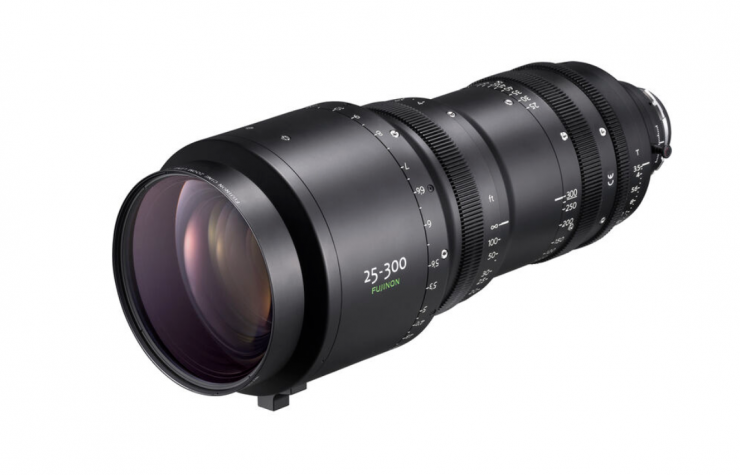
This isn’t the first time FUJINON has made a cine servo zoom with this type of focal range. The ZK25-300mm T3.5 to T3.85 Cabrio Lens (PL Mount) has been around for many years, however, that lens is around 3x heavier and about 50% longer in length.
Duvo Series
In March last year, Fujifilm announced the FUJINON HZK25-1000mm F2.8-F5.0 PL Mount (Duvo 25-1000) box-type broadcast zoom lens, also known as “Duvo Box”. The Duvo 25-1000, is also a Super 35 lens.
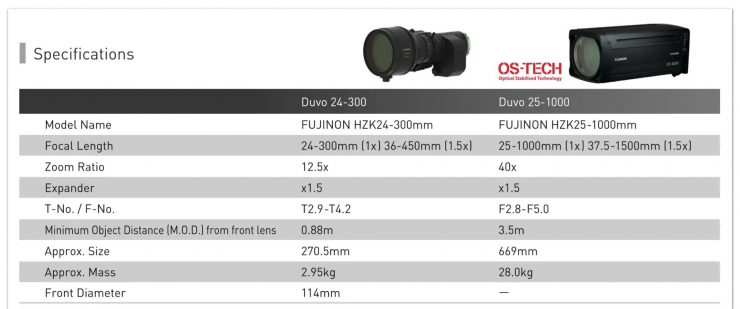
FUJINON also has an additional 14-100mm wide-angle zoom lens that will be in the Duvo series.
First Impressions
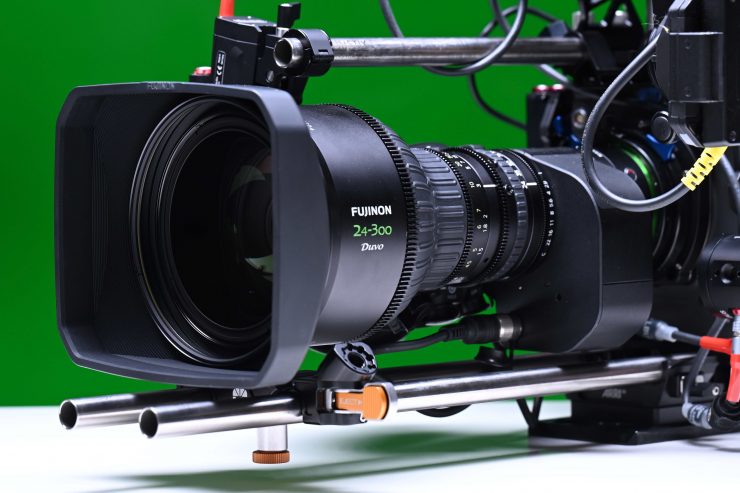

FUJINON Duvo HZK24-300mm T2.9-T4.2 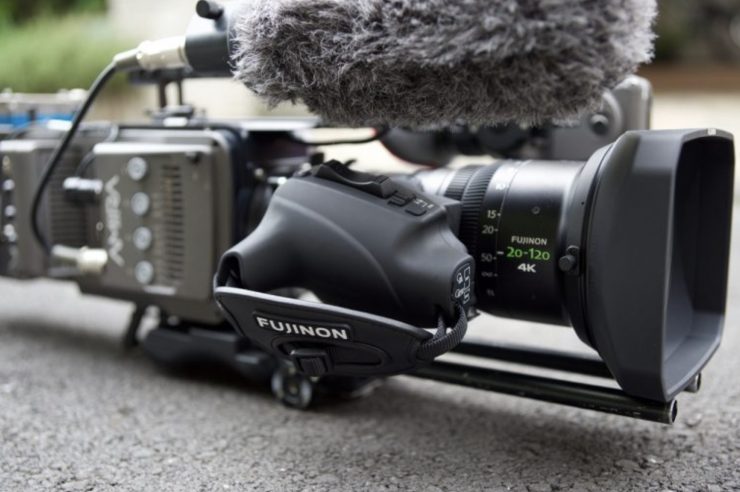
FUJINON XK6x20 20-120mm T3.5 Cabrio 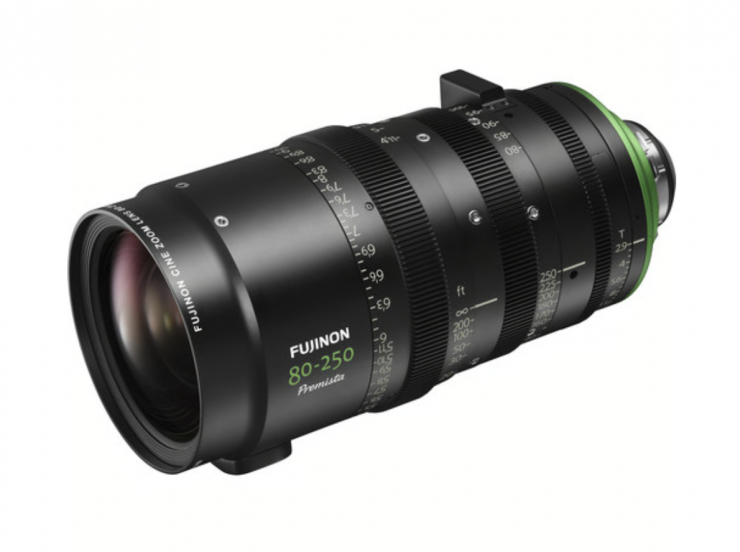
FUJINON Premista 80-250mm T2.9-3.5 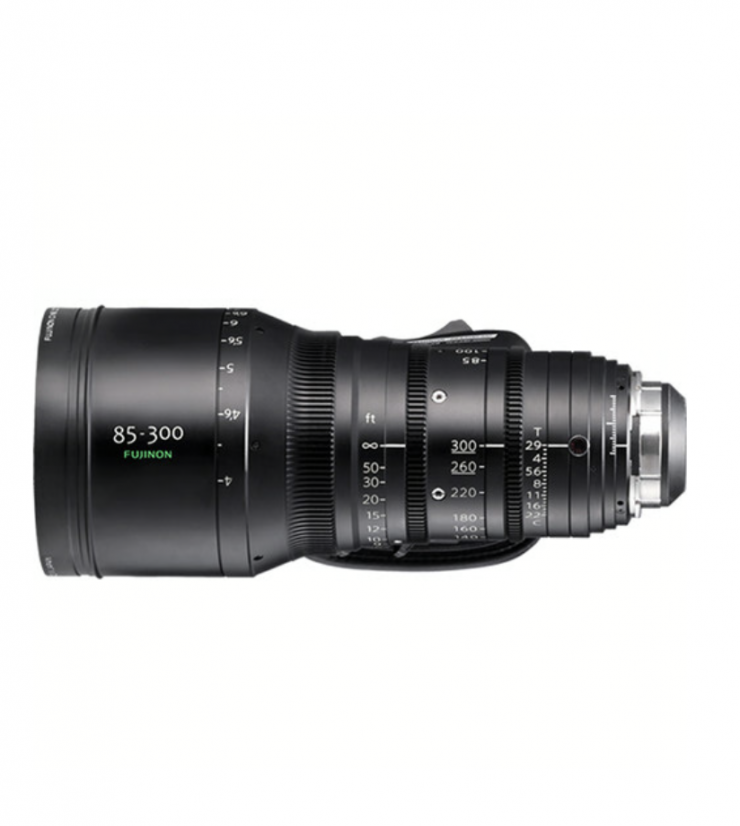
FUJINON ZK 85-300mm T2.9-4.0 Cabrio Lens
The FUJINON Duvo HZK24-300mm looks similar to other FUJINON lenses such as the XK6x20 20-120mm T3.5 Cabrio, the Premista series, and the ZK Cabrios. They all have the same understated look and minimal company branding.
Lens Design

Making a reasonably compact cine zoom with a manageable weight and big focal range is no easy task and that is why we haven’t seen that many options come to market. In this space, it has always been FUJINON and Canon that have led the way.
FUJINON states that a wide array of aberrations are thoroughly suppressed by using highly precisely polished large-diameter aspherical lenses and super ED lenses. The lens is also stated to be able to suppress ghosting, flare, and color bleeding.
Focal Range
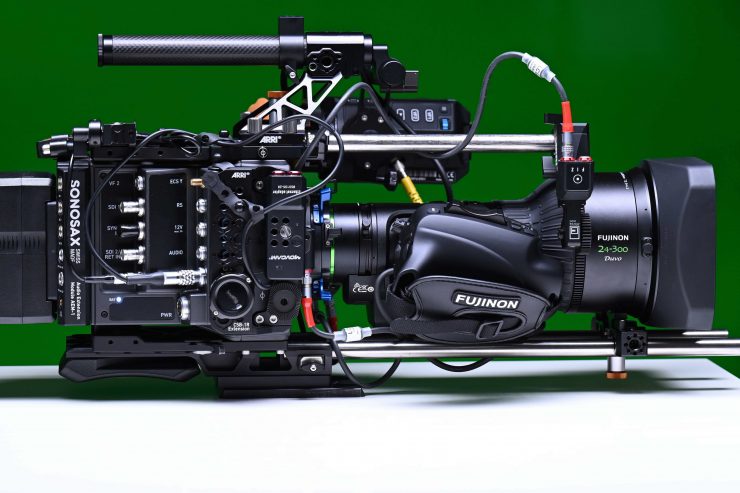
One of the biggest caveats of using a full-frame or larger sensor digital cinema camera is that the lenses become larger, heavier, and have reduced focal ranges. All you have to do is look at the FUJINON Premista series as a good example. As these lenses cover a 46.3mm image circle you couldn’t make a 24-300mm T2.9-T4.2 unless you are prepared to design a lens that would weigh probably 15+kg, be 1m+long and cost north of $100,000 USD.
By making the Duvo HZK24-300mm essentially a S35 lens, FUJINON can give users a greater focal range and keep the weight and size to manageable proportions.
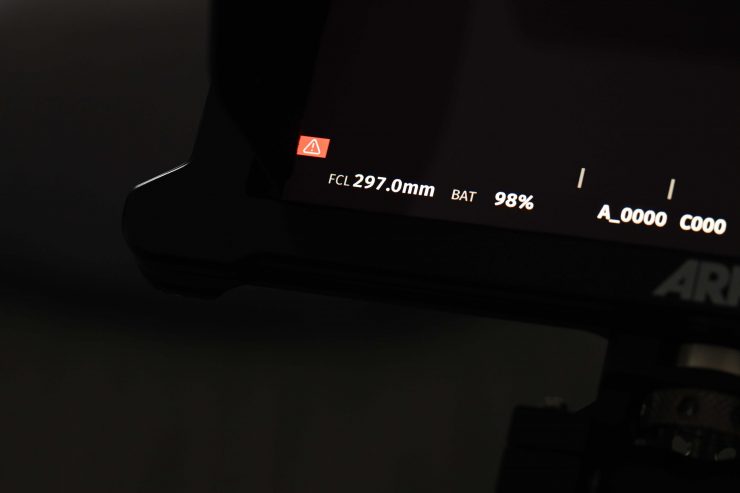
Now, even though the lens is listed as 24-300mm, my camera when utilizing the Cooke /I Technology showed a maximum focal range of 297mm.
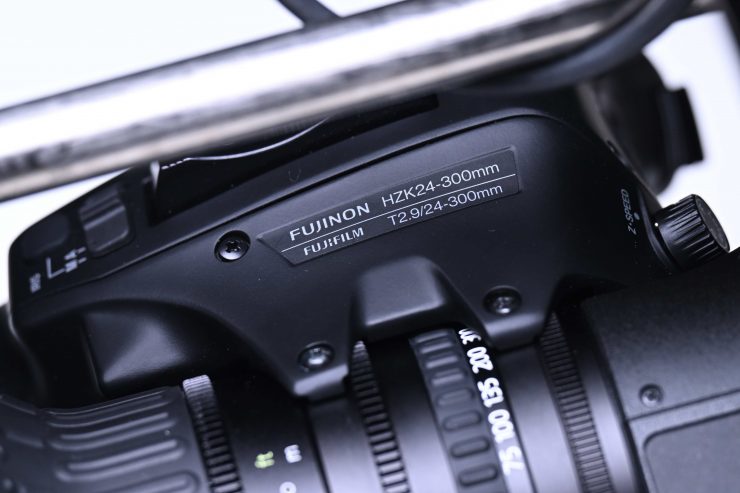
The focal range of 24-300mm (36mm to 450mm with the 1.5x extender) is extremely impressive. Having this type of range covers you for a lot of shooting applications without needing to change lenses.
The long-end reach of the lens is very impressive and having a built-in 1.5x extender is an added bonus. For shooting sports, events, and wildlife the focal range of the Duvo is going to certainly suit a lot of peoples needs.
Yes, you could certainly argue that 24mm isn’t wide enough on a S35 sensor, and I would agree with you.
I personally found 24mm too tight to consider this a one-stop lens that I could use for everything. However, you could still get away with it if that was the only choice you had. Having the built-in macro can also save you if subjects get too close to you.
I actually own a FUJINON XK6x20 20-120mm T3.5 Cabrio, and there are lots of instances (of course this depends on what you are shooting) where 20mm just isn’t wide enough.
You could also make an argument that a lot of shooters would have preferred an 18-200mm over a 24-300mm, but making a cine zoom lens with a wider focal range adds significant weight and size. It also would place a lot more weight at the front of the lens, and therefore, make it hard to balance and use when shooting handheld.

All you need to do is have a look at the Canon CN7x17KSA cine-servo zoom to see how that all of the weight is at the front of the lens. This is the challenge with lens design and making something that can go quite wide, while also having a long focal reach.
As I always say, unfortunately, when it comes to optics you can’t have your cake and eat it too. You simply can’t have a full frame, lightweight cine zoom with a decent constant T- stop and a big focal range. Yes, you can make your lens housing out of more exotic and expensive materials, but that is going to increase the price while only saving you a handful of weight. Staying with lenses that only cover S35 sensors makes the most sense given the target market that this lens is being aimed at.
I am sure everyone would love to have a full frame 25-250mm T2.9 cine zoom that weighs 2.5kg and costs $3,000 USD, well guess what, that is never going to happen. It is always going to be a compromise for lens manufacturers when it comes to weight, size, focal length, and T-stop.
T-stop

As I mentioned earlier, the lens has a maximum aperture of T2.9 from the wide-angle end of 24mm to 207mm. Over 207mm it does start ramping up to T4.2. What I found is that you really don’t start to notice any significant ramping till the lens reaches around 244mm, when you get to about 278mm and over you will start to see it clearly darken. From what I experienced I would say that it is probably going from around T3.5 to T4.2 as soon as you reach around 278mm.
It doesn’t come as any big shock that the lens doesn’t maintain a constant T-stop across its entire range. If it did, FUJINON would have had to make the lens larger and heavier.
Having a constant T2.9 aperture from 25-207mm is impressive. Yes, it does ramp and you need to be very aware of that if you are zooming above 207mm as you will need to make an aperture adjustment to maintain the same exposure. If you are wide open at T2.9 you also need to be aware that if you start coming towards the long end, you are going to lose light. This is hardly the end of the world, but it is the caveat of keeping the Duvo’s size and weight to a minimum.
You can’t have your cake and eat it too, but FUJINON at least lets you take a substantial bite!
Image Coverage
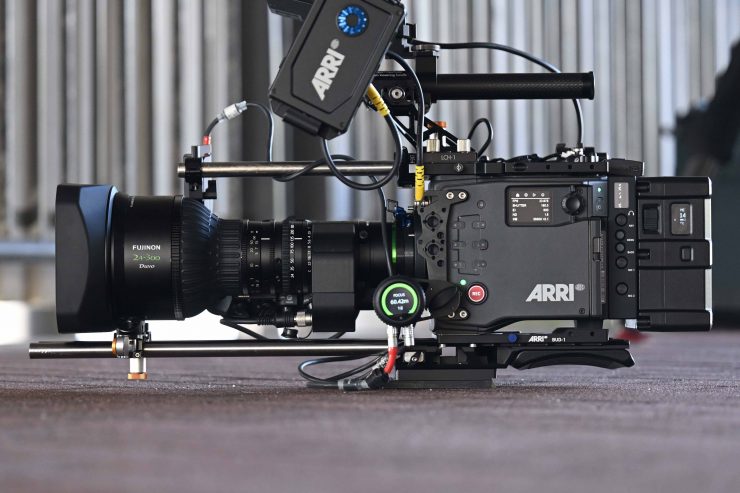
The lens when used with a camera equipped with a Super 35mm sensor, covers an image circle of 28.5mm over the entire zoom range.
I did find that there was vignetting when shooting in the 4.6K 16:9 sensor mode on the ARRI ALEXA 35 from 24mm to around 50mm. This is because the ALEXA 35 sensor is actually a bit larger than traditional Super 35mm sensors and in the 4.6K 16:9 sensor mode the image circle requirement is 32.12mm.
When it is used with 35mm full-frame equivalent sensor, it covers an image circle of 41.3mm over the entire zoom range, but only with the 1.5x extender engaged.
Cooke /I Technology
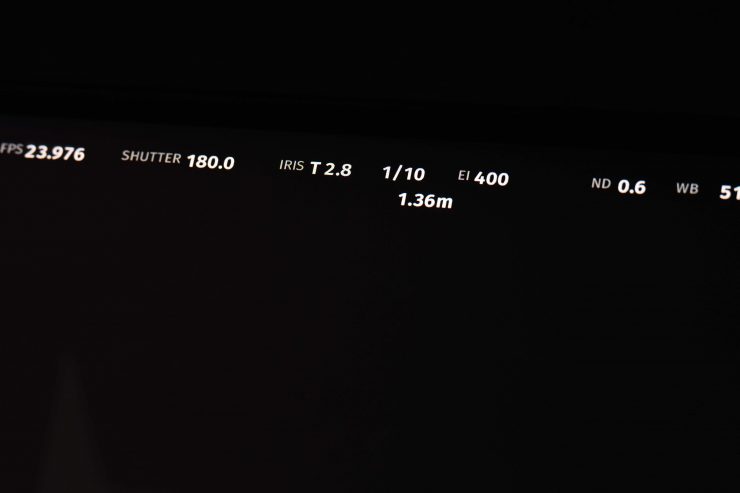
The lens is equipped with Cooke /I Technology so it will communicate lens information to compatible cameras. This is handy as it lets you see your focal length and T-stop.
Size & Weight
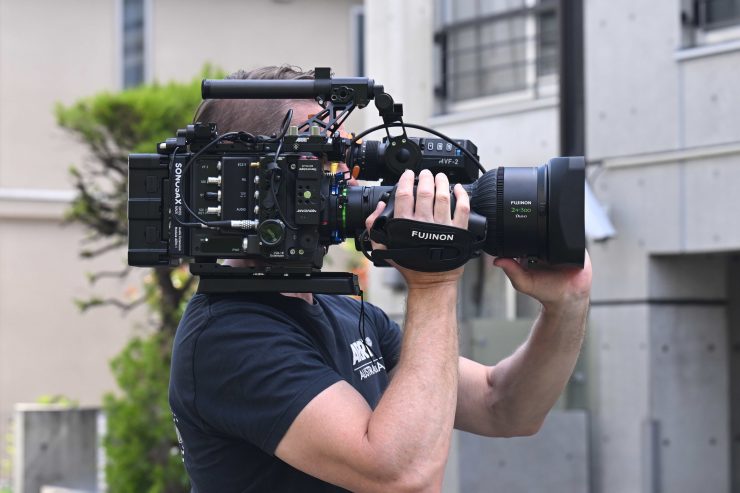
The FUJINON Duvo HZK24-300mm was designed to be a very versatile portable lens that can be used with a tripod, shoulder-mounted, or placed on a Steadicam or crane. It is 27cm / 10.65″ in length and it weighs just 2.95 kg / 6.5 lb.

The lens looks heavier than it is. I was actually surprised when I first picked it up as I expected it to feel a lot heavier. That’s not to say that this is a lightweight lens, but gives its capabilities the fact that FUJINON has managed to keep the weight under 3kg is very impressive.
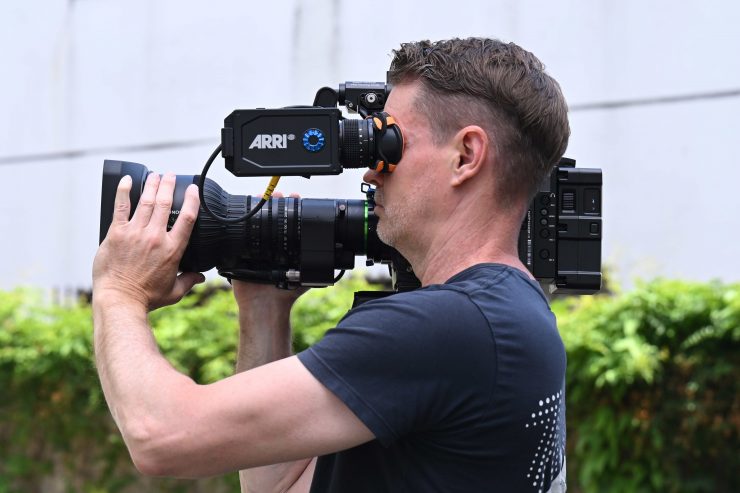
The lens balances well on the shoulder with the right-sized camera. It would certainly be more suited to use with cameras such as the ARRI ALEXA 35, ARRI AMIRA, ALEXA Mini, Panasonic Varicam LT, Blackmagic URSA 12K, etc. While you could use it on smaller-sized digital cinema cameras it would take some work to get it balanced correctly on your shoulder.
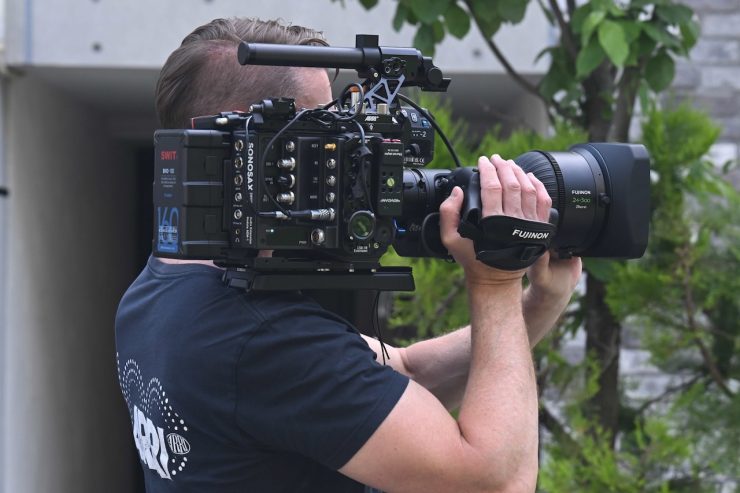
I could position the camera on my shoulder so that the weight was nicely distributed and my arm was in a nice L shape.
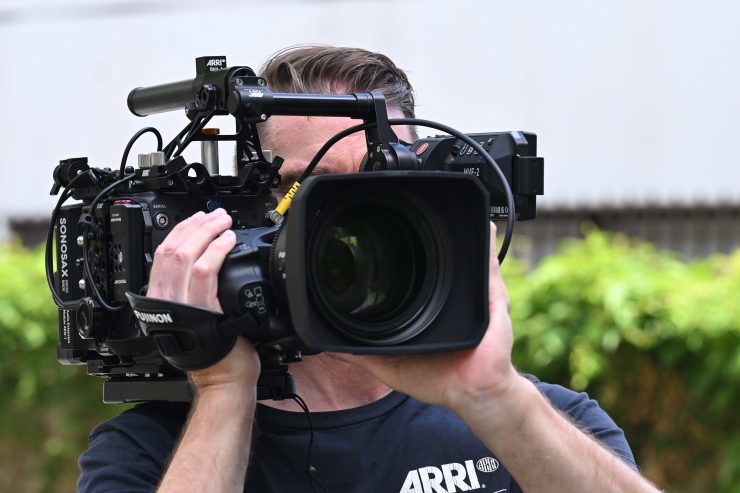
Now, despite being relatively comfortable, it is still a lot of weight and you will get fatigued operating like this for sustained periods of time.

So how does that size and weight compare to the closest competition? Well, let’s find out.
| WEIGHT | LENGTH | |
| FUJINON Duvo HZK24-300mm | 2.95 kg / 6.5 lb | 27cm / 10.65″ |
| FUJINON ZK25-300mm T3.5 to T3.85 Cabrio | 8.9 kg / 19.6 lb | 40.1 cm / 15.8″ |
| Canon CINE-SERVO 25-250mm T2.95 | 3.04 kg / 6.7 lb | 27.43cm / 10.8″ |
As you can see, essentially the Canon and FUJINON Duvo are about the same weight and size.
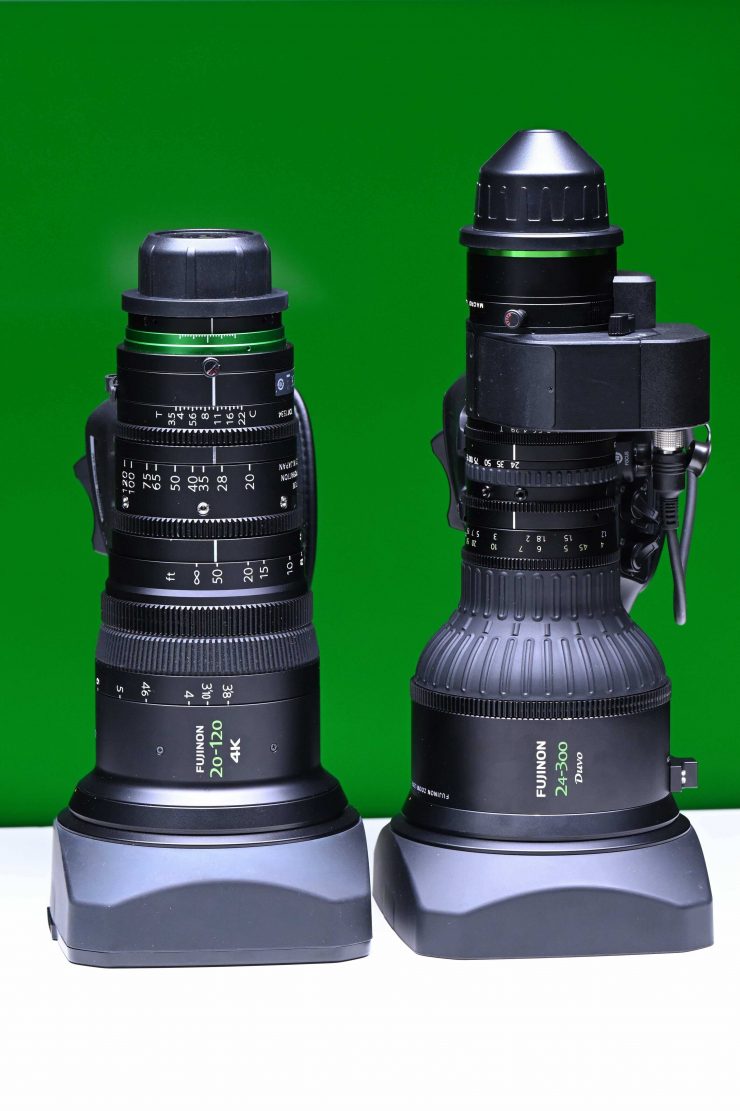
As another comparison above you can see how it compares size-wise to the FUJINON XK6x20 20-120mm T3.5 Cabrio. The XK6x20 20-120mm T3.5 Cabrio weighs 2.4 kg / 5.3 lb, so the FUJINON Duvo HZK24-300mm is only 550g heavier.
How do you power it?
You can simply connect the lens cable to the lens connector of the camera. Now, if your camera does not have a lens connector, you can connect the cable to the connector on the bottom of the lens.
On a lot of PL mount cameras, you will be able to power the lens simply by connecting the cable to the connector on the bottom of the lens. Power will be supplied through the lens mount.
If power cannot be supplied from the camera, you would need to connect the cable to a power supply device such as an external power supply. The rated voltage is DC 12V/operating range: DC 10V to 17V. Using a voltage outside the operating range may cause a malfunction.
–
Build Quality & Operation
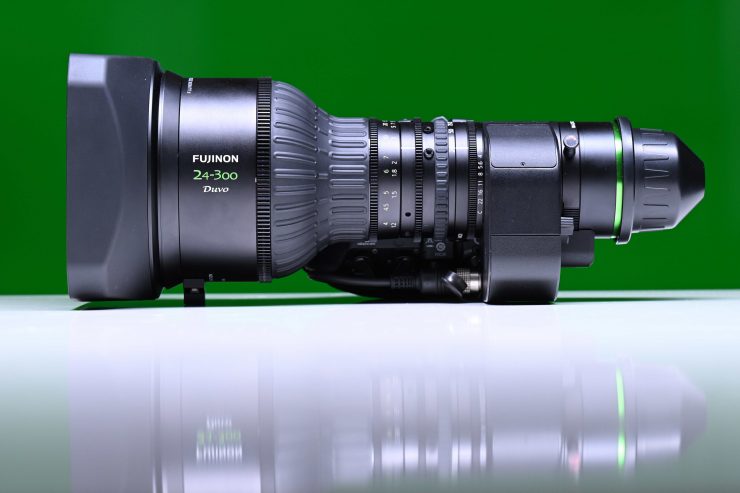
What I personally look for when it comes to lenses is build quality and mechanical consistency. With expensive cine lenses, this is what you expect.
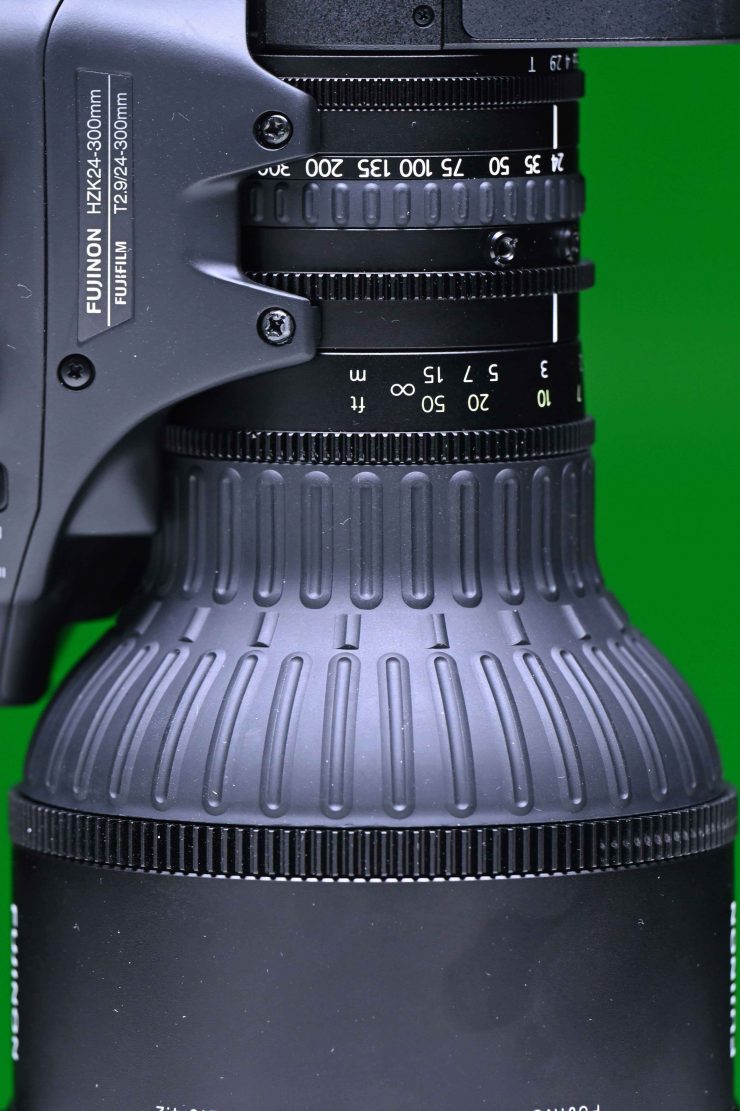
The FUJINON Duvo HZK24-300mm is very well-made and solidly constructed. As I mentioned earlier, it actually looks heavier than it is.
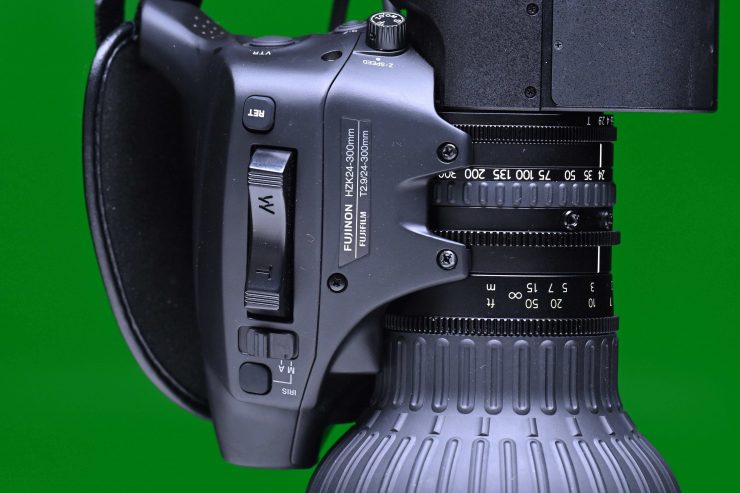
The lens has a very similar feel as other FUJINON lenses. If you are familiar with FUJINON 2/3″ ENG/EFP lenses or the Cabrios then you will be right at home.
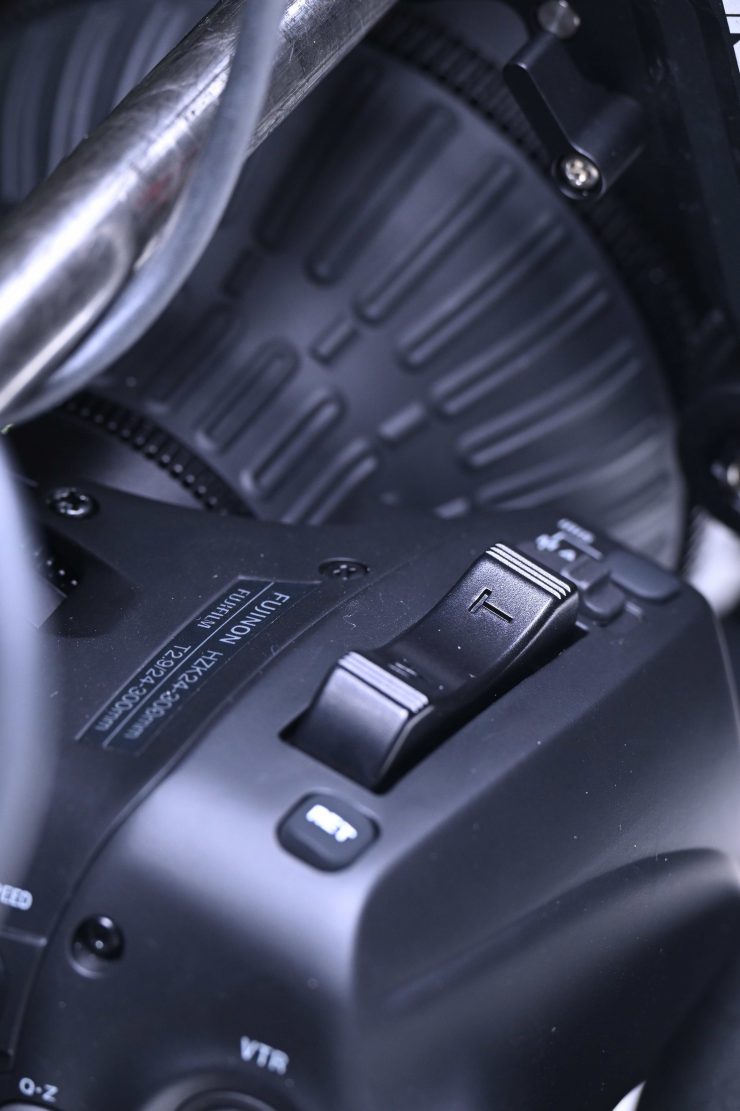
The servo mechanism is very tactile and easy to use. You can do very smooth zooms at a variety of speeds. Near the zoom rocker there is also a Manual/Auto Iris switch and a button that you can press that will quickly do an auto override while you are in manual mode.
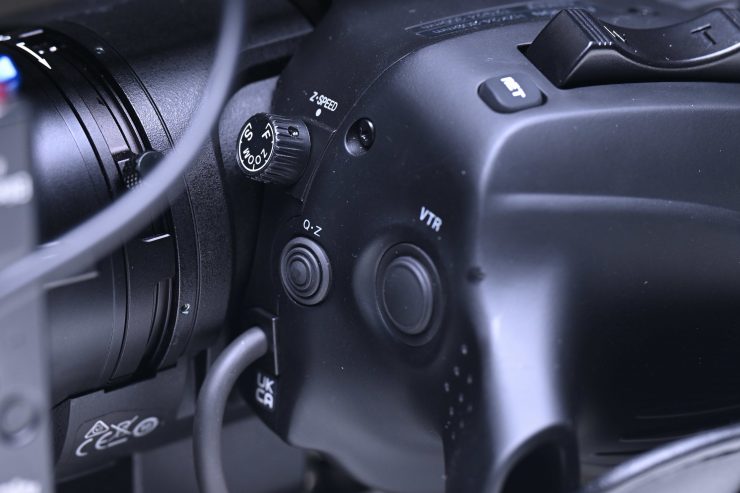
The zoom speed dial, Quick Zoom button, and the VTR stop/start button are also easy to access and use.
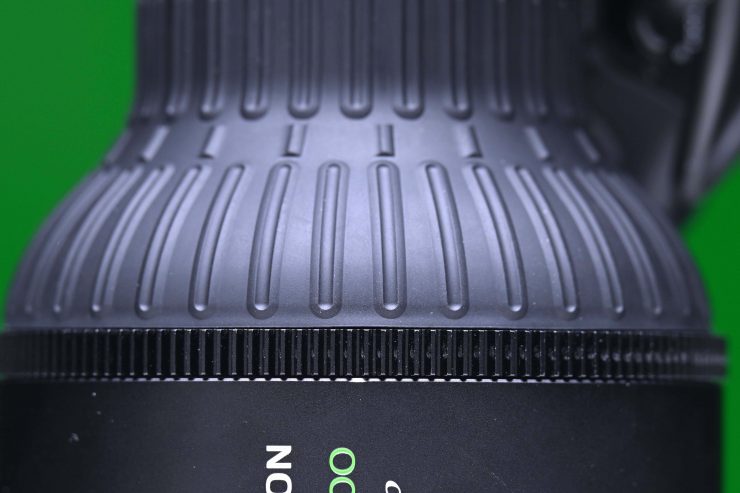
The focus barrel is easy to grip as it features a textured surface. This is easy to hold even in inclement weather conditions or when you are wearing gloves.
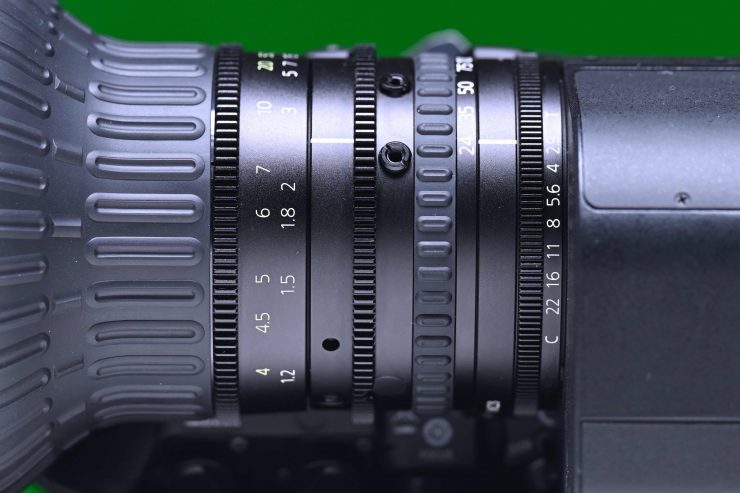
The markings are clearly and concisely laid out and they are easy to see.
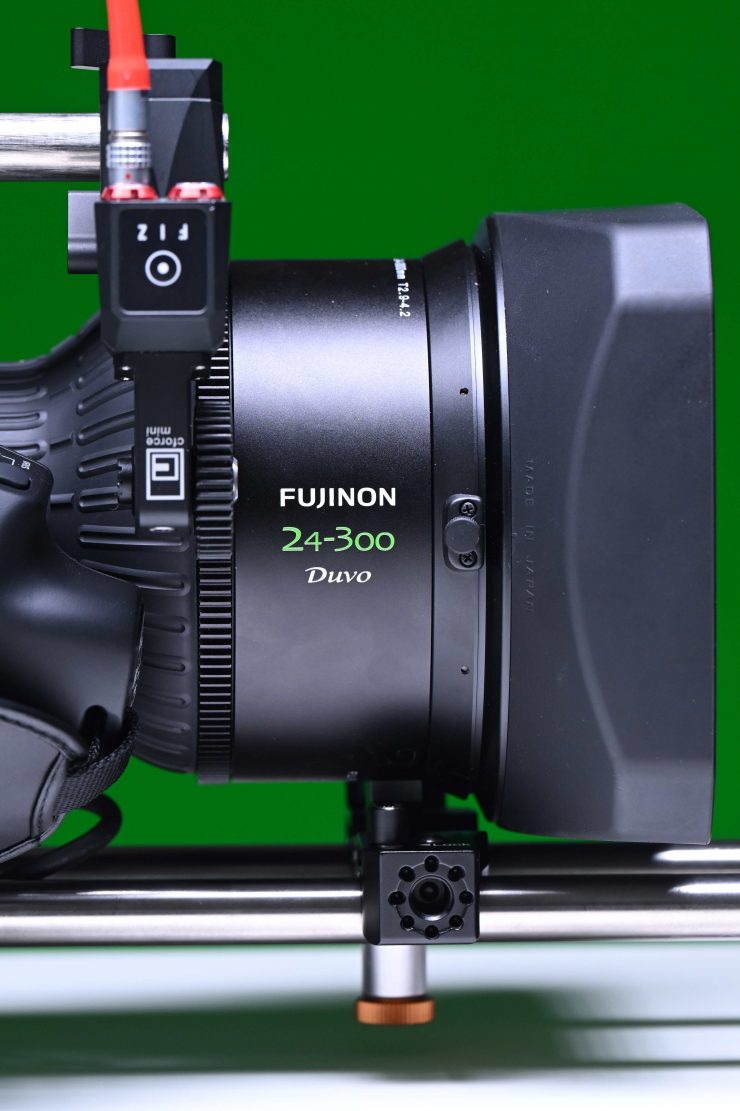
The lens has industry standard 0.8 focus, and smaller sized iris, and zoom pitch gears so you can run FIZ motors or a follow focus if you want to.

As far as usability is concerned, the only thing that slightly bothered me was that when you plug the lens connector cable into the bottom of the lens it can get in the way of the hand grip. It would have been nice to have seen FUJINON put a little cable mounting point somewhere to avoid this from happening.
Close Focus
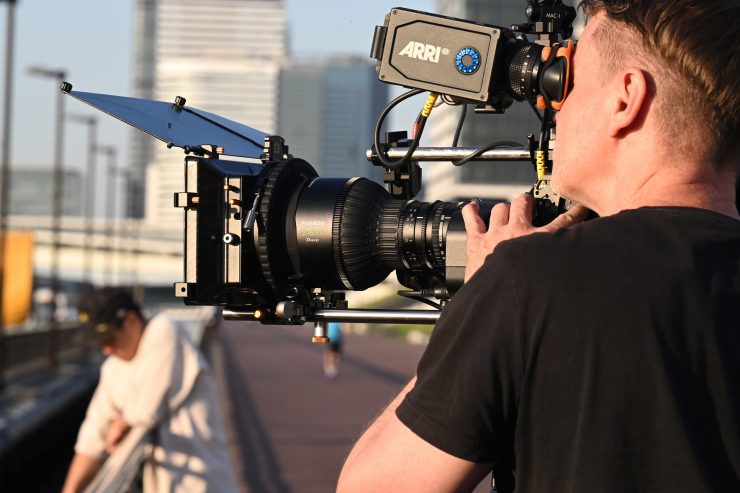
The Duvo HZK24-300mm can focus at a distance of 4′ / 1.2 m when used at 24mm.
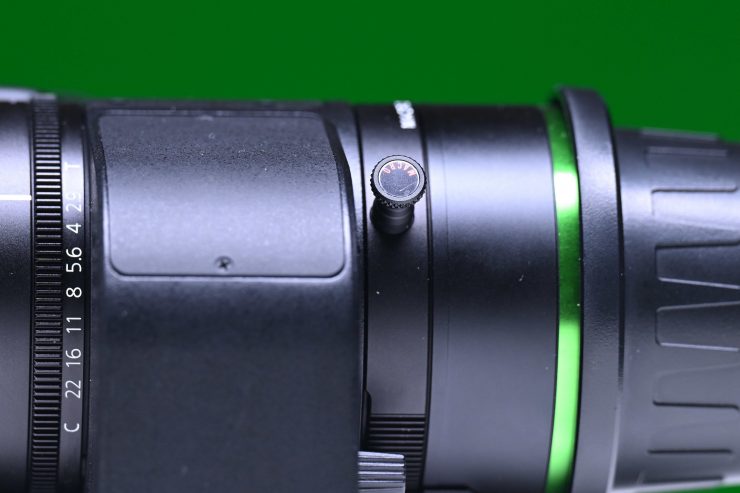
You can also use the built-in macro if you need to focus on closer subjects. This is done by moving a little switch on the back of the lens.
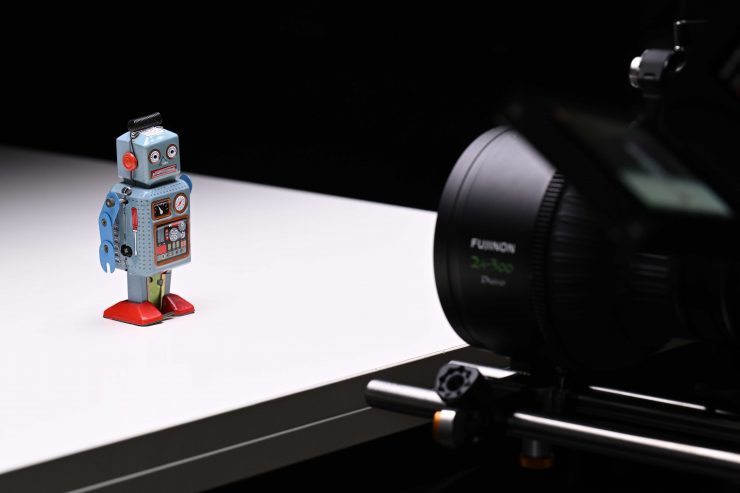
You can only use the macro at wider focal lengths and I found at 24mm I could focus at a distance of 58cm / 22.83″ from the focal plane. At 50mm I could focus at a distance of 89cm / 35.03″ from the focal plane.
So how does this close focus compare to some other S35 cine zooms with similar focal lengths that are on the market? Below you can see.
| MOD | |
| FUJINON Duvo HZK24-300mm | 4′ / 1.2 m |
| FUJINON ZK25-300mm T3.5 to T3.85 | 3.9′ / 1.18 m |
| CINE-SERVO 25-250mm T2.95 Cinema Zoom | 4′ / 1.2 m |
As you can see the MOD distance is the same for both the FUJINON Duvo HZK24-300mm and the Canon 25-250mm T2.95 Cinema Zoom.
Other Features
The FUJINON Duvo HZK24-300mm is equipped with the same type of drive unit that you will find on the Cabrios and the XK 20-120mm. This type of drive unit is very familiar to anyone who has worked with broadcast ENG lenses.
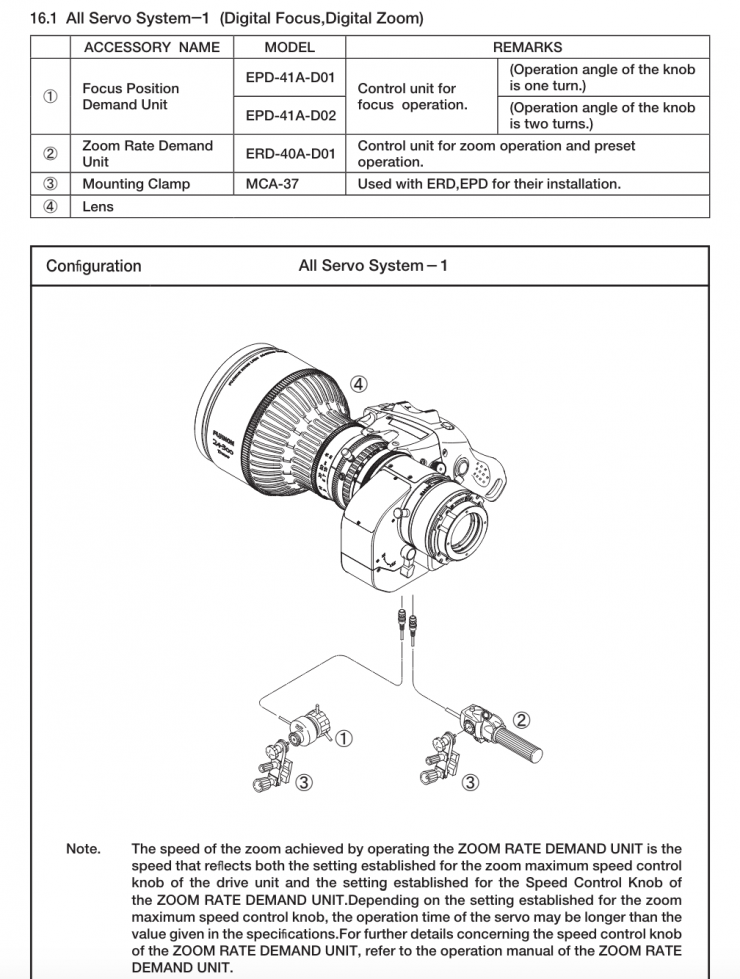
The lens can also be operated in the same shooting style as broadcast lenses using zoom and focus demands.
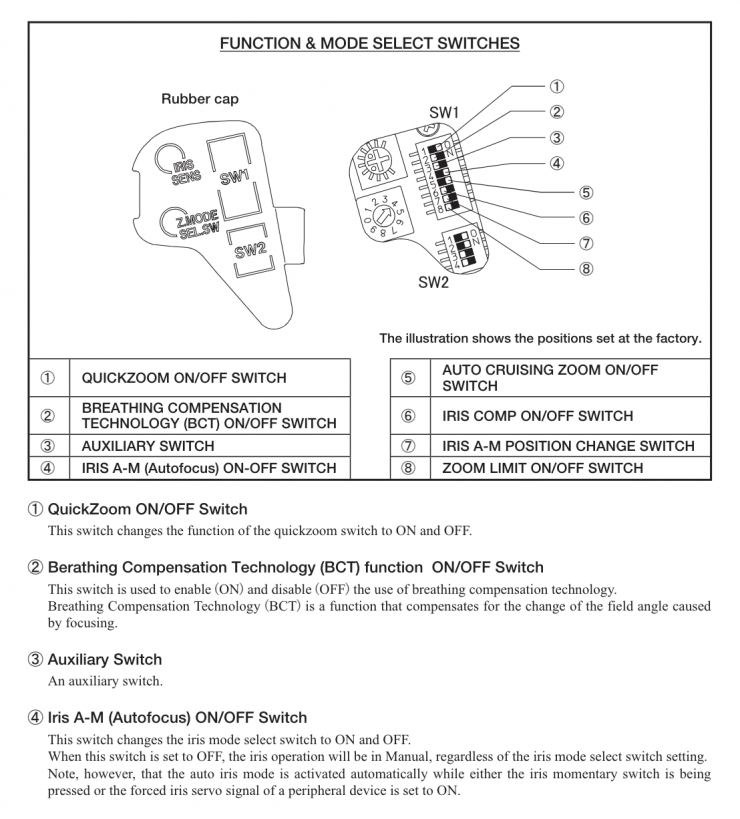
Just like on most of the FUJINON servo units, there is a removable rubber cover that lets you change some of its parameters.
As I mentioned earlier, the lens comes with industry-standard 0.8 mod gears, threads for mounting lens support, and it has a 114mm front filter diameter.
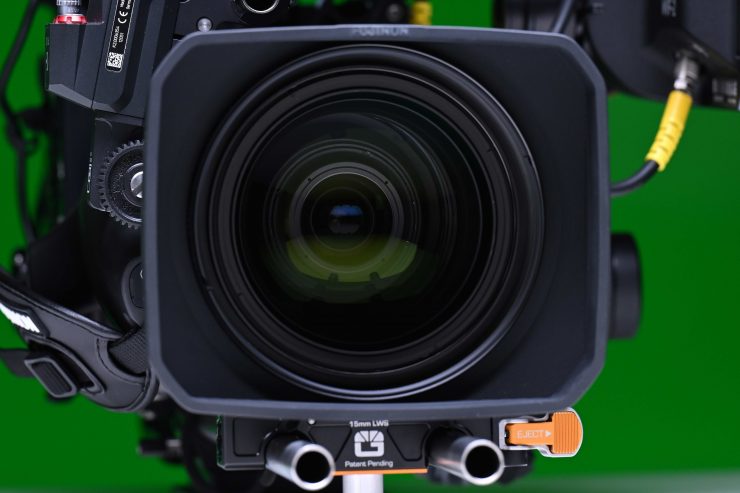
It also comes with a lens hood.
FUJINON has made the lens compatible with the “ZEISS eXtended Data” system. This means that lens metadata at the time of shooting can be output externally for post or when working in virtual production environments.
What is nice is that the Duvo also features “Remote Back Focus (RBF)” that allows you to adjust the flange back remotely via the camera or a robotic control panel.
Pin Assignment of Connectors
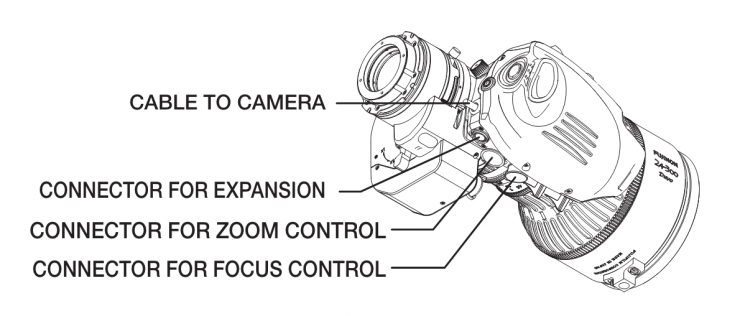
Lens Breathing
FUJINON states that the Duvo is equipped with “Breathing Compensation Technology” that automatically compensates for breathing (angle of view fluctuations) that occurs when focusing. You can actually turn this feature on or off.
The caveat with the “Breathing Compensation Technology” is that you can only use it at certain focal lengths. The way it works is that the lens will actually zoom slightly as you move the focus ring to compensate for the image shift. Because it has to zoom it won’t work at wide or long focal lengths.
I tested out the lens at various by doing large focus throws with the “Breathing Compensation Technology” turned on and off. While it does work reasonably well, I personally didn’t like the results as I felt that it was a little distracting. I actually preferred to have this function turned off, but it is nice that it is there if you need it.
If you don’t have the “Breathing Compensation Technology” turned on then the lens certainly does exhibit a lot of lens breathing. I usually find with lenses like this that I am not doing massive focus throws so the breathing didn’t bother me too much. If FUJINON was to design a lens like this with little to no focus breathing it would require a lot more complexity which would probably ultimately make it larger, heavier, and more expensive.
Sharpness
Fujinon lenses have always generally been pretty sharp. Above you can see how the Duvo HZK24-300mm performs when used at various T-stops and focal lengths. The reason I shoot the small robot is that it has very finite details and textures on it. I also have shot countless sharpness tests with lenses using this same robot over the years so it allows me to have a baseline and comparison. This test is a difficult one when using a lens that has a long focal reach because you are filling the frame with a small object.
So how did the lens perform?
The Duvo HZK24-300mm maintains good sharpness across its entire focal range. It is certainly sharper at wider to mid-focal lengths when used wide open at T2.9. I would say that sharpness when used wide open starts to drop off slightly once you reach around 150mm and above, but not by much. I was impressed with the sharpness of this lens even at the long end when it was used wide open. Even if you zoom in 200% on the image the lens was still able to resolve fine detail which was impressive.
At T4 the lens is slightly sharper, but not by much.
T5.6 is where the lens is nice and sharp across the focal range as you would expect.
At T8 it is probably at its sharpest, however, there really isn’t a massive real-world difference that jumps out at you.
How about the 1.5x extender? Usually, extenders are noticeably softer, but I found that the one on the Duvo was pretty good. I found that the 1.5x extender provided excellent results and I didn’t notice any big drop-off in sharpness which was surprising. Yes, when used wide open with the doubler it will be slightly softer, but the results are still very good.
Lens Flare
Fujinon lenses tend to have pretty well-controlled flare characteristics mainly because of the lens design and the use of modern coatings.
I found that you could still get some decent flare with this lens. Please have a look at the test footage further down in the review so you can see how the lenses perform when it comes to flare in real-world conditions.
Chromatic Aberration
The lens didn’t show massive amounts of real-world chromatic aberration when used wide open. Even when shooting in very high contrast conditions and heavily backlit environments the lens performed well. I pushed the lens very hard in difficult conditions and I didn’t find anything that overly concerned me when it came to chromatic aberration.
Color Tone
The FUJINON Duvo HZK24-300mm T2.9-T4.2 has the same sort of look as other FUJINON lenses. It is a little on the cool side and it has a pretty neutral color tone. I found the color rendition to be pretty consistent with the XK6x20 20-120mm T3.5 Cabrio that I own.
Real World Thoughts
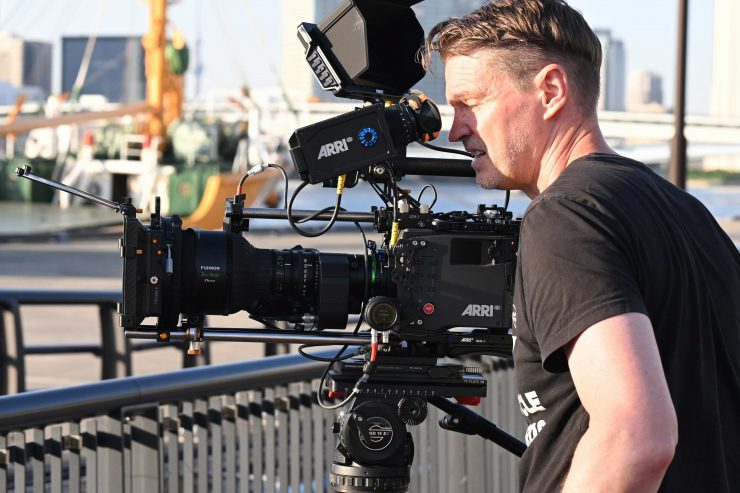
The FUJINON Duvo HZK24-300mm T2.9-T4.2 is a very impressive lens and it was fantastic to be able to go out and shoot a wide variety of material with a single lens. Having a 24-450mm range (with the in-built 1.5x extender) in a lens of the size with this weight is fantastic.

Usually, with lenses such as this that have a large focal range, there are optical compromises that need to be made. What surprised me is that those compromises seem to be very small, and FUJINION has done a fantastic job with the optical quality of this lens. It has good sharpness across its focal range and even the 1.5x extender provides good results.
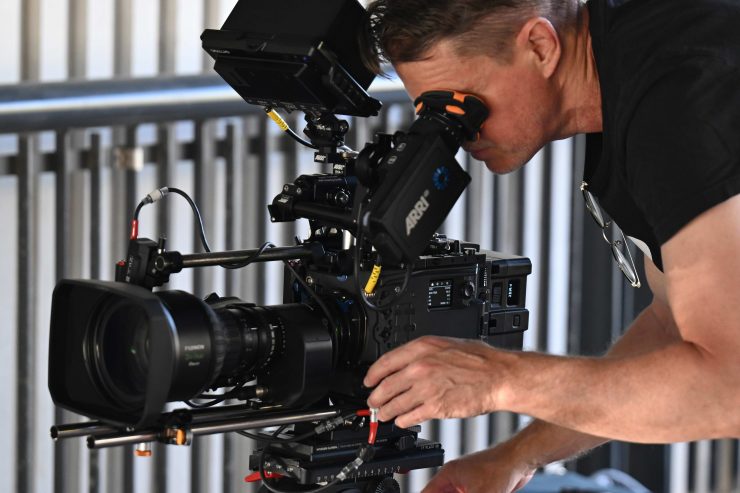
Yes, the lens does ramp, but I think that is a small price to pay for keeping the size and weight to a minimum.
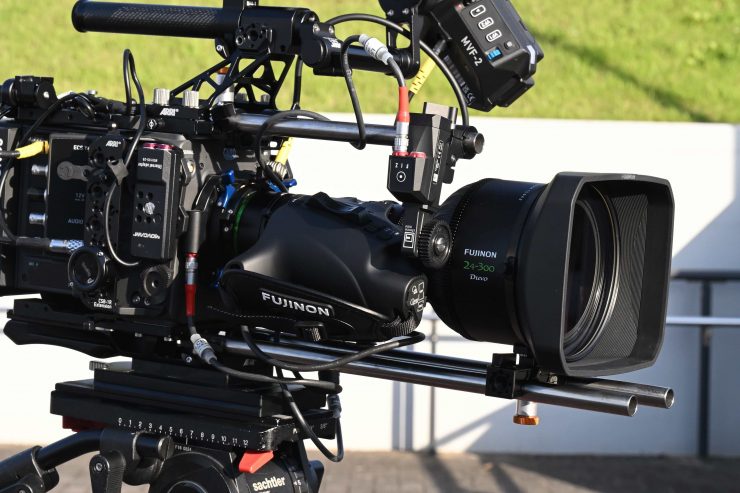
I went and took some shots with the lens to see how it performed in the real world. Technical tests are all good and well but you really need to see how a lens performs in real-world environments both in terms of ease of use and lens performance.
Above you can see some footage captured with the lens. I was interested to see how it performed at various focal lengths and what the overall usability was like. I purposely wanted to push the lenses by shooting in very contrasty and difficult conditions. There isn’t much point in just shooting nice shots when testing out a lens. You want to push it optically to see what it does.
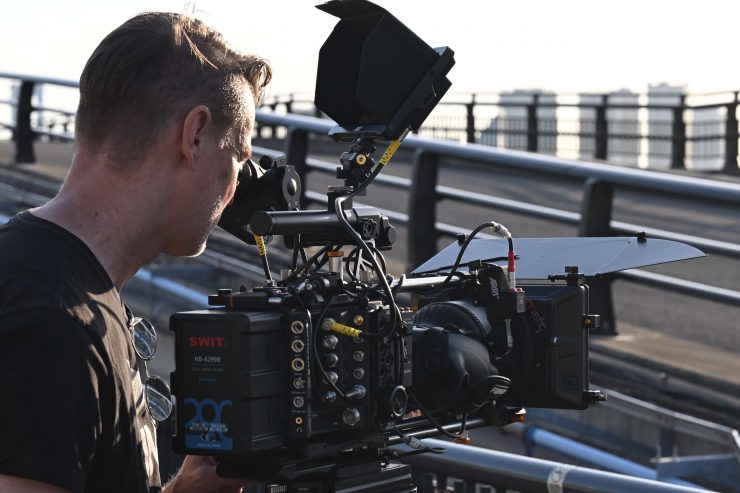
What I found is that the lens performs exceptionally well in heavily backlit or contrasty lighting conditions. It maintains a lot of contrast in these situations and the chromatic aberration is very well controlled.

Now, a lot of people want funky flares and lens blooming, etc. but you are not going to get that with this lens. In saying that you can certainly still get some nice flares.
Because of the long focal range, you can compress up your background without needing to shoot at T2.8 to T4.
The bokeh is reasonably nice, although it will start to go a little stop sign-shaped as you start to stop the lens down.
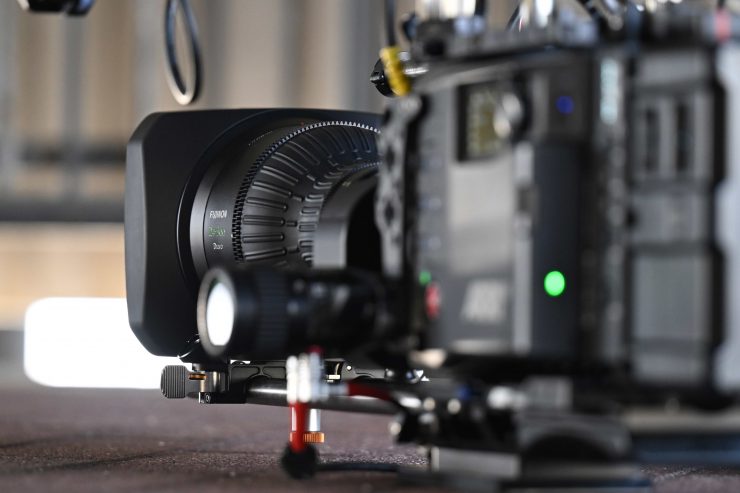
The lens was easy to use and operate, and the focus throw is actually fairly large at 280°, but I still found making finite adjustments at the longer end of the focal range when you are at T2.9 or T4 can be a little tricky. The lens has been designed so it is easy to use and operate if you are working by yourself or in small crews.
This lens really is the closest thing to a broadcast 2/3″ ENG lens that I have ever used.
The overall optical performance of this lens is very good. I thought that when using it on the long end or with the 1.5x extender the images may be a little soft, especially when used wide open, but the results were still good. The lens has good sharpness without being overly sharp.
Competition
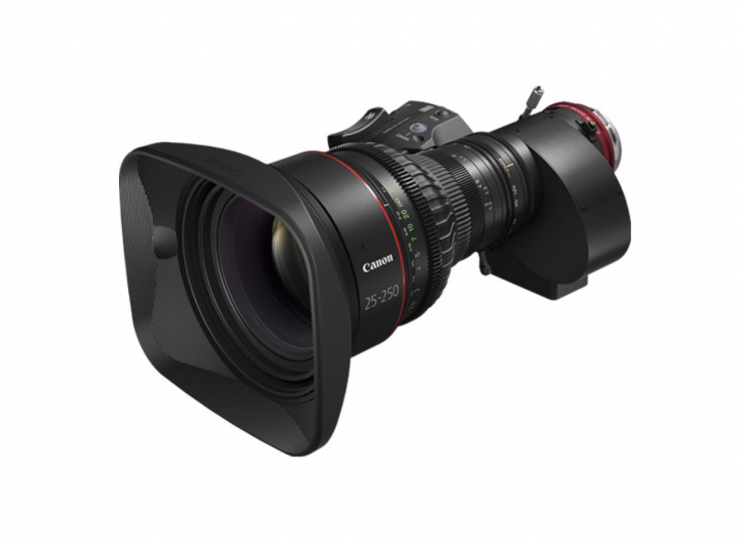
Competition for the FUJINON Duvo HZK 24-300mm comes in the form of the Canon CINE-SERVO 25-250mm T2.95 Cinema Zoom Lens (PL Mount) and FUJINON’s own ZK25-300mm T3.5 to T3.85 Cabrio Lens (PL Mount).
Price
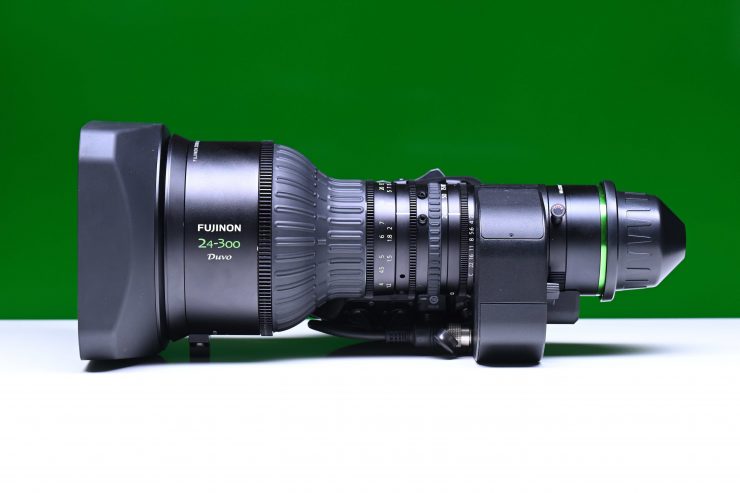
The FUJINON Duvo HZK 24-300mm retails for $31,999 USD which makes it very good value for money given its focal range, size, and weight.
So how does the price compare to some other S35 cine zooms with similar focal lengths that are on the market? Below you can see.
| PRICE | |
| FUJINON Duvo HZK24-300mm | $31,999 USD |
| FUJINON ZK25-300mm T3.5 to T3.85 | $44,000 USD |
| Canon CINE-SERVO 25-250mm T2.95 Cinema Zoom | $29,999 USD |
Even though $31,999 USD might sound expensive, I personally think that it offers better value for money than the competing Canon CINE-SERVO 25-250mm T2.95 Cinema Zoom as it offers a longer focal reach.
Specifications

Who is this lens aimed at?
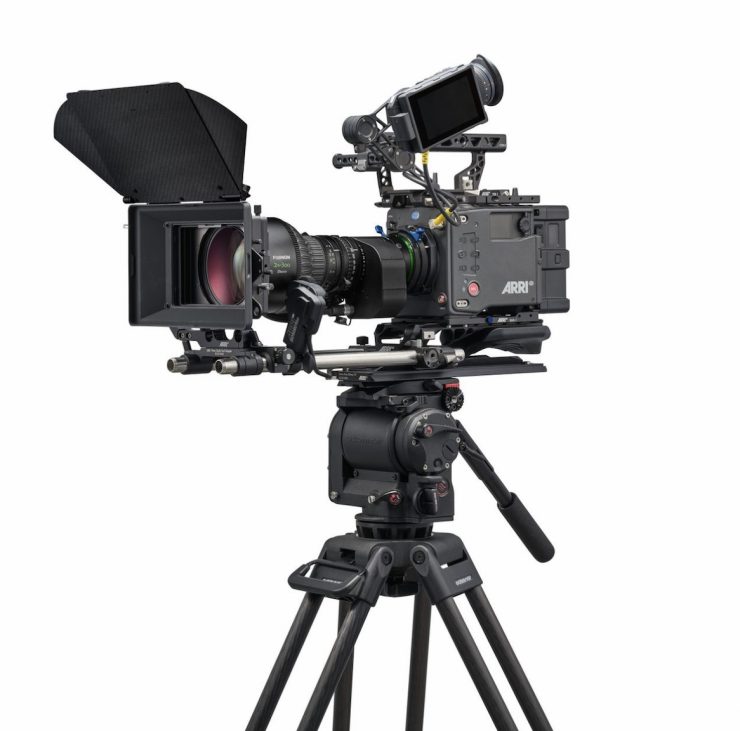
The FUJINON Duvo HZK 24-300mm is probably going to be a very popular lens, especially for sports coverage. I can see NFL films and the NBA buying quite a few of these. A lens with this zoom range that is under 3kg is an impressive feat of engineering.
They would also be good choices for documentary coverage and when shooting certain types of wildlife.
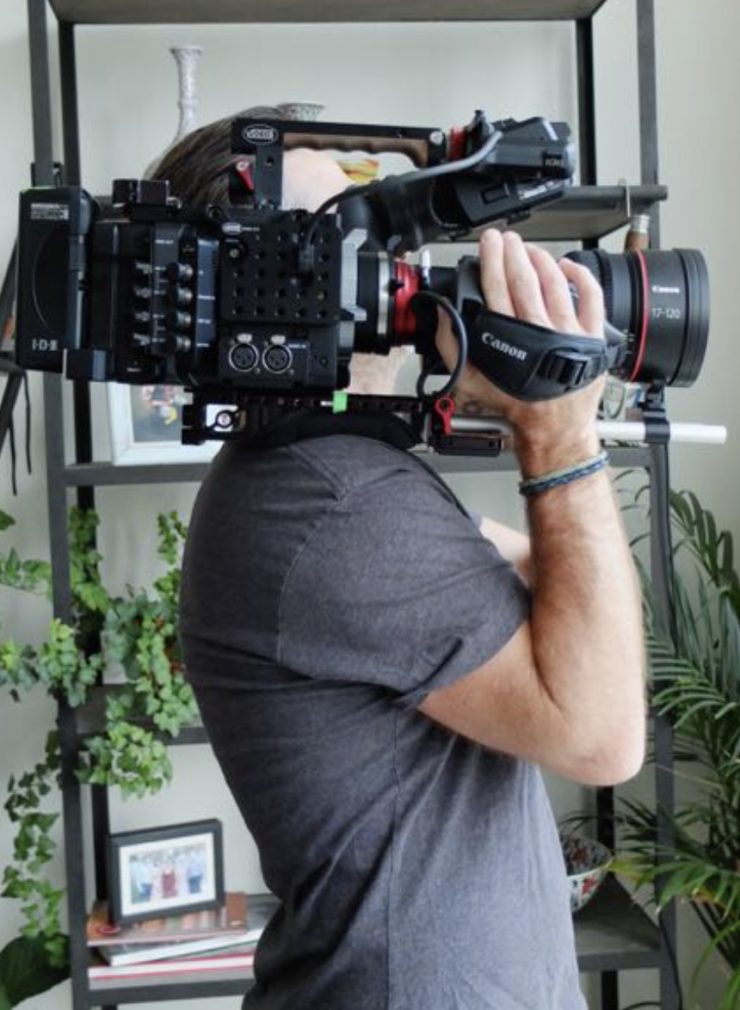
One of the caveats with these type of cine zooms when shoulder mounting them is that with a lot of them, most of the weight is located at the front of the lens and this can put a lot of pressure on your wrist and forearm. You can also have issues with balancing your rig as you need to push it a long way back on your shoulder which can make it difficult to access camera controls. It also means that they are more suitable to use with mid to large-sized digital cinema cameras.
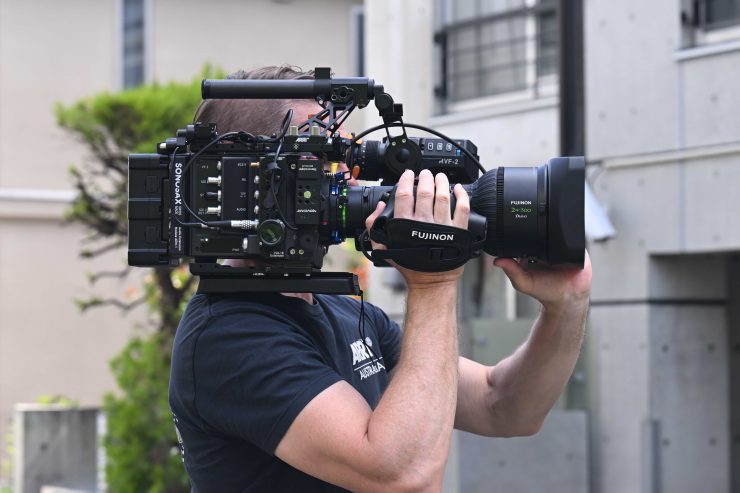
What was nice about the FUJINON Duvo HZK24-300mm T2.9-T4.2 is that it isn’t overly front heavy which does make it easier to use on the shoulder.
The other caveat is that 24mm is not overly wide on a S35 sensor and arguably some users would prefer to have a wider lens at the expense of having the extra length. The problem is, it’s a lot easier to make a zoom that starts at 24mm than one that starts at 18mm if you need to have a large focal range and keep the weight to a minimum.
Conclusion
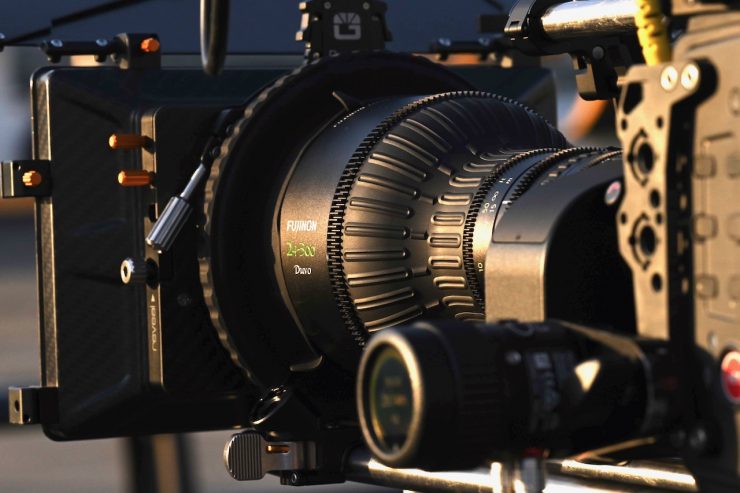
I really enjoyed using the FUJINON Duvo HZK24-300mm. It was nice to be able to shoot a wide array of content with just a single lens.
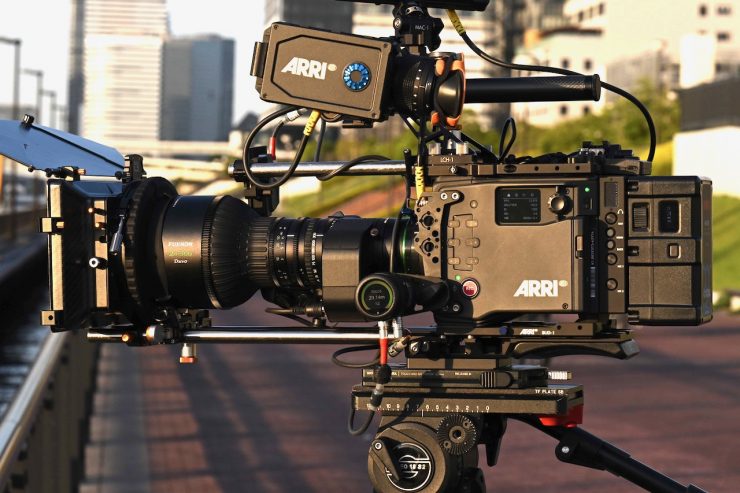
You would think that making a lens that is this size and weight that provides a massive focal range at a reasonably consistent T-stop would involve having to make a lot of compromises, but FUJINON has proved otherwise. The optical performance of this lens is impressive and there really wasn’t any time when I was using it that I felt that the results I was getting weren’t up to scratch.
The flare and contrast of the lens may not be to everyone’s taste. The lens maintains good sharpness across its focal range and even when it is used wide open.
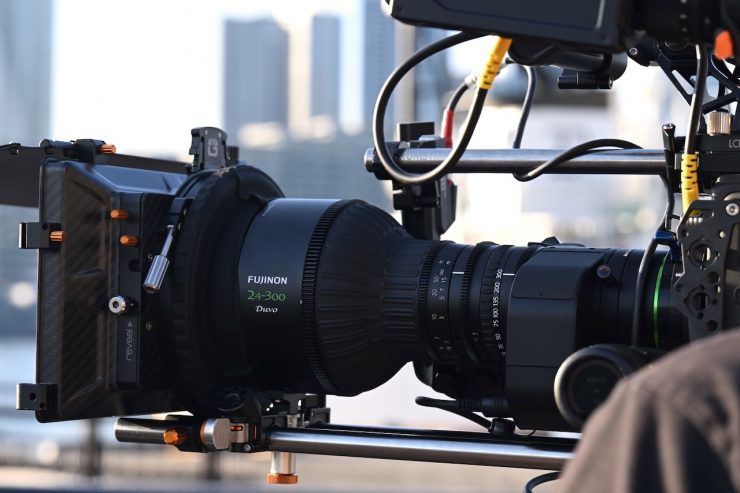
The lens is easy to operate and having a servo zoom is always a nice feature as it gives you added versatility, especially when you are working by yourself.
The biggest benefit of lenses with a PL mount is that you can use them on almost any camera, whereas if you choose other mounts, you are predominantly locked into using those lenses on a select number of cameras.
The FUJINON Duvo HZK24-300mm isn’t going to be a lens for everyone given its price and size, but for those looking for an all-in-one solution for higher-end S35 digital cinema cameras, it is hard to beat.
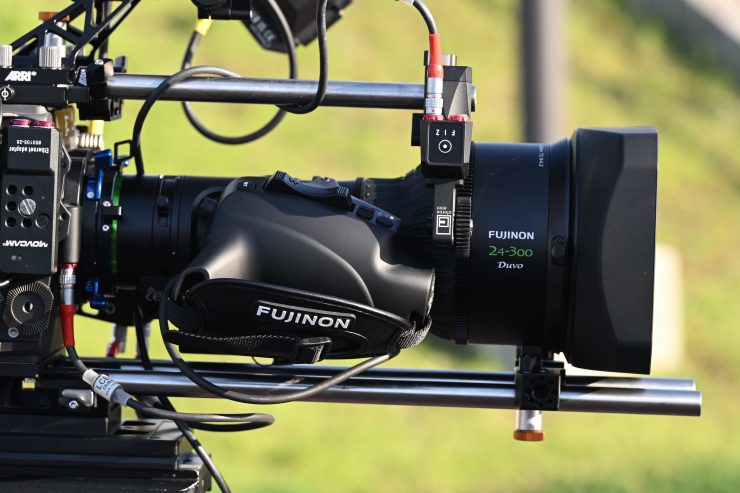
As I always say, there are no shortcuts with optics, and FUJINON has certainly pushed the boundaries with this lens.
The FUJINON Duvo HZK24-300mm T2.9-T4.2 is an outstanding lens that provides fantastic results in a workable size and weight. I would highly recommend the Duvo to anyone who wants the closest thing to an all-in-one S35 lens.

